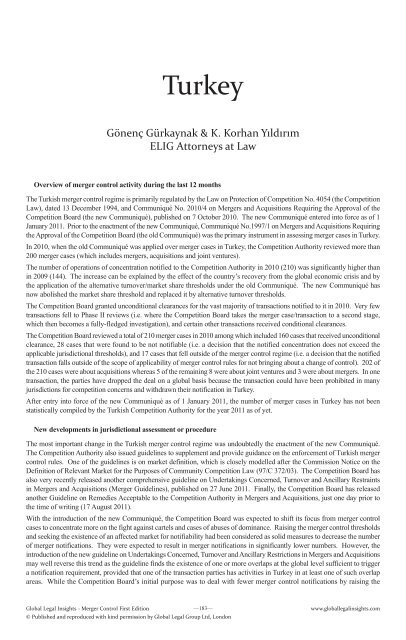Merger Controls First Edition - J Sagar Associates
Merger Controls First Edition - J Sagar Associates
Merger Controls First Edition - J Sagar Associates
You also want an ePaper? Increase the reach of your titles
YUMPU automatically turns print PDFs into web optimized ePapers that Google loves.
Turkey<br />
Gönenç Gürkaynak & K. Korhan Yıldırım<br />
ELIG Attorneys at Law<br />
Overview of merger control activity during the last 12 months<br />
The Turkish merger control regime is primarily regulated by the Law on Protection of Competition No. 4054 (the Competition<br />
Law), dated 13 December 1994, and Communiqué No. 2010/4 on <strong>Merger</strong>s and Acquisitions Requiring the Approval of the<br />
Competition Board (the new Communiqué), published on 7 October 2010. The new Communiqué entered into force as of 1<br />
January 2011. Prior to the enactment of the new Communiqué, Communiqué No.1997/1 on <strong>Merger</strong>s and Acquisitions Requiring<br />
the Approval of the Competition Board (the old Communiqué) was the primary instrument in assessing merger cases in Turkey.<br />
In 2010, when the old Communiqué was applied over merger cases in Turkey, the Competition Authority reviewed more than<br />
200 merger cases (which includes mergers, acquisitions and joint ventures).<br />
The number of operations of concentration notified to the Competition Authority in 2010 (210) was significantly higher than<br />
in 2009 (144). The increase can be explained by the effect of the country’s recovery from the global economic crisis and by<br />
the application of the alternative turnover/market share thresholds under the old Communiqué. The new Communiqué has<br />
now abolished the market share threshold and replaced it by alternative turnover thresholds.<br />
The Competition Board granted unconditional clearances for the vast majority of transactions notified to it in 2010. Very few<br />
transactions fell to Phase II reviews (i.e. where the Competition Board takes the merger case/transaction to a second stage,<br />
which then becomes a fully-fledged investigation), and certain other transactions received conditional clearances.<br />
The Competition Board reviewed a total of 210 merger cases in 2010 among which included 160 cases that received unconditional<br />
clearance, 28 cases that were found to be not notifiable (i.e. a decision that the notified concentration does not exceed the<br />
applicable jurisdictional thresholds), and 17 cases that fell outside of the merger control regime (i.e. a decision that the notified<br />
transaction falls outside of the scope of applicability of merger control rules for not bringing about a change of control). 202 of<br />
the 210 cases were about acquisitions whereas 5 of the remaining 8 were about joint ventures and 3 were about mergers. In one<br />
transaction, the parties have dropped the deal on a global basis because the transaction could have been prohibited in many<br />
jurisdictions for competition concerns and withdrawn their notification in Turkey.<br />
After entry into force of the new Communiqué as of 1 January 2011, the number of merger cases in Turkey has not been<br />
statistically compiled by the Turkish Competition Authority for the year 2011 as of yet.<br />
New developments in jurisdictional assessment or procedure<br />
The most important change in the Turkish merger control regime was undoubtedly the enactment of the new Communiqué.<br />
The Competition Authority also issued guidelines to supplement and provide guidance on the enforcement of Turkish merger<br />
control rules. One of the guidelines is on market definition, which is closely modelled after the Commission Notice on the<br />
Definition of Relevant Market for the Purposes of Community Competition Law (97/C 372/03). The Competition Board has<br />
also very recently released another comprehensive guideline on Undertakings Concerned, Turnover and Ancillary Restraints<br />
in <strong>Merger</strong>s and Acquisitions (<strong>Merger</strong> Guidelines), published on 27 June 2011. Finally, the Competition Board has released<br />
another Guideline on Remedies Acceptable to the Competition Authority in <strong>Merger</strong>s and Acquisitions, just one day prior to<br />
the time of writing (17 August 2011).<br />
With the introduction of the new Communiqué, the Competition Board was expected to shift its focus from merger control<br />
cases to concentrate more on the fight against cartels and cases of abuses of dominance. Raising the merger control thresholds<br />
and seeking the existence of an affected market for notifiability had been considered as solid measures to decrease the number<br />
of merger notifications. They were expected to result in merger notifications in significantly lower numbers. However, the<br />
introduction of the new guideline on Undertakings Concerned, Turnover and Ancillary Restrictions in <strong>Merger</strong>s and Acquisitions<br />
may well reverse this trend as the guideline finds the existence of one or more overlaps at the global level sufficient to trigger<br />
a notification requirement, provided that one of the transaction parties has activities in Turkey in at least one of such overlap<br />
areas. While the Competition Board’s initial purpose was to deal with fewer merger control notifications by raising the<br />
Global Legal Insights <strong>Merger</strong> Control <strong>First</strong> <strong>Edition</strong><br />
—183—<br />
© Published and reproduced with kind permission by Global Legal Group Ltd, London<br />
www.globallegalinsights.com


